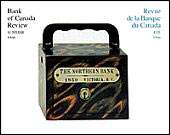August 11, 1996
August 10, 1996
Inflation expectations and Real Return Bonds
The existence of a market for Real Return Bonds in Canada provides a direct tool with which to measure market expectations of inflation by comparing the yields on these bonds with those on conventional Government of Canada long-term bonds. However, there are other factors besides inflation expectations that may affect the yield differential. After reviewing these factors, the authors note that they can lead to a potentially large bias in the level of inflation expectations. The changes in the differential over time may, nonetheless, be a good indicator of movements in long-run inflation expectations. Based on this measure, expectations of long-run inflation have declined since late 1994.
Content Type(s):
Publications,
Bank of Canada Review articles
Topic(s):
Interest rates
